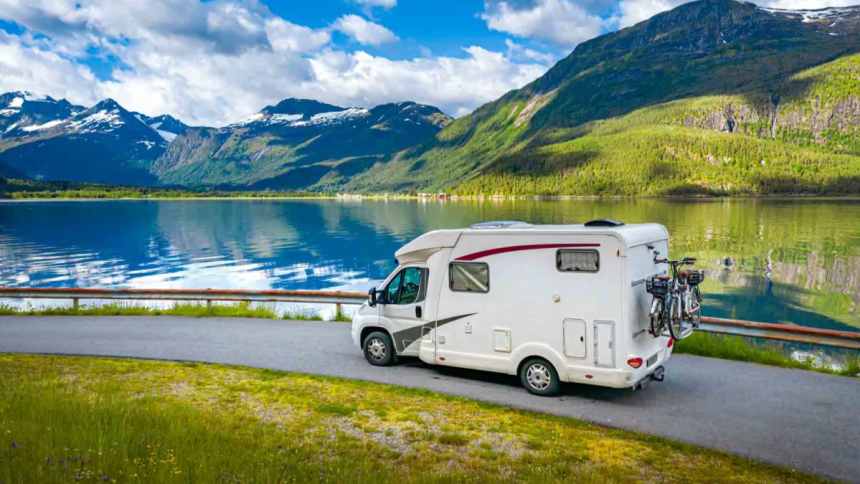Travel doesn’t have to mean expensive hotels, airport stress, or strict schedules. With an RV, you can explore the country at your own pace — stop when you want, stay where you like, and enjoy the freedom of the open road.
And no, you don’t need to buy one. Renting an RV is one of the easiest and most affordable ways to try the lifestyle. Whether you’re planning a weekend getaway or a cross-country road trip, RV rentals give you the comfort of home without the cost of traditional travel.
In this guide, we’ll show you how to get started — from picking the right RV to finding great deals and planning your first route.
Why Renting an RV Is More Affordable Than You Think
There are many reasons why RV rentals are more affordable. Here are some.
You Don’t Need Flights
Plane tickets for even one person can be pricey, especially last minute. Add in multiple travelers, baggage fees, and airport food, and the cost quickly climbs. Renting an RV means no plane tickets, no delays, and no security lines. You drive at your own pace and take the scenic route.
For families or small groups, the savings can be huge compared to booking flights for everyone. Plus, you get to enjoy the journey as much as the destination.
You Can Cook Your Own Meals
Eating out every day adds up fast. Most RVs come with kitchens—fridge, stove, microwave, and storage. That means you can make your own meals, pack snacks, and avoid fast-food traps on the road.
Grocery shopping is much cheaper than restaurant bills, especially on longer trips. Whether it’s a quick breakfast, a campfire dinner, or coffee with a view, having your own kitchen saves money and adds comfort to your trip.
One Rental Covers Travel and Stay
When you rent an RV, you’re getting two things in one: transport and accommodation. You don’t need to pay separately for a car and a hotel. That alone can cut your travel costs in half, explains Bill Sanders, from QuickPeopleLookup.com.
Instead of juggling bookings and comparing prices for both, one rental handles it all. You’ll also save time by skipping the hotel check-ins and car rental desks.
You Control the Budget
RV travel is flexible. You decide how far you drive, where you stay, and what you spend. Want to save on fuel? Choose a shorter route. Want to skip expensive RV parks? Park at free or low-cost spots.
You’re not locked into fixed prices like with package holidays. You can make adjustments anytime during your trip to keep spending in check.
Blending Mobility with Memorable Stays
While RV rentals let travelers cut down on hotel bills, many are pairing their road trips with occasional stays at unique boutique accommodations. This mix of mobility and indulgence offers the best of both worlds: the freedom of the open road and the rejuvenation of a destination designed for relaxation. Choosing places with distinctive features, like private hot tubs and scenic settings, allows travelers to recharge in ways that standard campgrounds simply can’t match.
Jonas Kloer, Founder of Hot Tub Hotelsrecommends, “Travelers today aren’t just looking for affordability; they’re seeking experiences that elevate their journey. After days on the road, a stay in a boutique hideaway with a private hot tub creates a balance between adventure and comfort—turning travel into something restorative rather than just economical.”
Types of RVs You Can Rent (And How to Pick the Right One)
Here are the types of RVs you can rent.
Class A Motorhome
Class A motorhomes are the largest RVs on the road. They’re basically rolling apartments with everything you need: a full kitchen, bathroom, dining area, bedroom, storage, and sometimes even a washer/dryer.
Most sleep 4–6 people comfortably, which makes them ideal for families or longer road trips where comfort matters. You get more space to stretch out, which helps on long drives. But there’s a trade-off — these vehicles are big and heavy. If you’re not used to driving something this size, it can feel confusing at first.
Class C Motorhome
Class C RVs are a great middle ground. They’re smaller than Class A but still offer a full setup: kitchen, bathroom, beds, and seating space. Most have a sleeping area over the cab, which gives you more room without needing a larger frame. They usually sleep 2–6 people, depending on the size.
These RVs drive more like a van or a large pickup, so they’re easier to handle for first-time renters. You won’t feel like you’re piloting a bus, and they fit into more campgrounds and parking spots. If you’re new to RVing and want all the essentials without the stress of driving something massive, this is a solid pick.
Class B Campervan
Class B RVs, also known as campervans, are the smallest motorhomes you can rent. They’re built into a standard van body and are very easy to drive—even for someone with no RV experience.
Most include a small bed, basic kitchenette, and sometimes a compact toilet or wet bath (a combined shower and toilet space). They’re perfect for solo travelers or couples who want to keep things simple. You can park them almost anywhere a regular car can go, which gives you more flexibility.
Travel Trailer
Travel trailers aren’t motorized — you tow them behind your vehicle. They come in many sizes, from tiny teardrop trailers to 30-foot setups with full kitchens and bathrooms. The big advantage is that once you set up camp, you can unhook the trailer and use your vehicle to explore, explains Desmond Dorsey, Chief Marketing Officer at Bayside Home Improvement.
This gives you more freedom and saves fuel. They’re usually cheaper to rent than motorhomes, but you’ll need a car or truck with towing power. Setup takes a bit more work (leveling, connecting utilities, etc.), so it’s better if you have some basic knowledge or are willing to learn.
Pop-Up Camper
Pop-up campers are compact trailers that fold down while you drive and expand into a tent-like space at your campsite. They’re super lightweight, easy to tow with most cars, and much more affordable than other RV types.
Inside, you’ll usually find two beds, a small dining space, and maybe a sink or stove. Some models include electricity or basic heating, but most don’t have bathrooms. These are great for summer trips, weekend getaways, or for people who want to camp comfortably without spending too much.
Lorand Pavai, Founder of EDGE Overland says, “The beauty of lightweight campers lies in their ability to bridge simplicity with capability. With the right build and features, even the most compact setups can handle rugged terrain while still offering comfort at camp. That balance is what makes them such an appealing entry point for travelers eager to explore beyond paved roads without sacrificing the essentials.”
Beginner Tips for a Smooth RV Experience
Here are some tips for beginners.
Take Time to Learn the Basics Before You Hit the Road
Marissa Burrett, Lead Design for DreamSofa explains, “Before you drive off, spend 30–60 minutes getting familiar with your RV. Learn how to hook up water, electricity, and sewage. Know how the generator works, how to refill propane, and how to dump the tanks properly.”
Ask the rental company to walk you through it — most will gladly show you. Record videos or take photos if needed. Knowing this stuff upfront saves you a lot of confusion at campsites later, especially if you arrive at night or in bad weather.
Don’t Plan to Drive Too Far Each Day
It’s easy to underestimate how tiring RV travel can be. Driving a larger vehicle takes more focus, especially on narrow roads, in windy conditions, or through traffic. Limit your daily drive time to 3–5 hours, especially in the beginning.
Give yourself time to stop, relax, and enjoy the places you visit. The journey is part of the fun — so take it slow, plan your route with breaks, and avoid rushing from point to point.
Pack Smart
Even the biggest RVs don’t have endless room. Pack light, and bring only what you’ll actually use. Focus on multipurpose items: clothes you can layer, shoes that work for hiking and town, and kitchen gear that covers basics. Use soft bags instead of suitcases — they’re easier to store, explains Experts from Lashkaraa – Anarkali.
Bring essentials like flashlights, a first-aid kit, and extension cords. And stock up on a few meals and snacks before you leave so you’re not stuck hunting for groceries on day one.
Always Book Your First Campsite in Advance
The first night is when you’ll be learning the ropes, so make it easy on yourself. Book your first campsite ahead of time — ideally one with full hookups (water, electricity, sewer) and easy pull-through parking. You’ll have time to settle in, test the systems, and get comfortable with the setup without extra stress.
After that, you can try more spontaneous stops if you want—but starting off with a confirmed site gives you peace of mind.
Expect Some Bumps, and Stay Flexible
Things might not go perfectly — and that’s okay. You might miss a turn, have trouble with hookups, or forget something small. RV travel is about freedom, not perfection.
Give yourself space to learn, laugh off little mistakes, and enjoy the adventure. Keep a simple daily checklist, stay friendly with fellow campers (they’re often happy to help), and focus on making good memories, not following a tight schedule. Flexibility is your best travel tool, finalizes Julian Lloyd Jones, from Casual Fitters.
Conclusion
Renting an RV is one of the easiest ways to explore the country without spending a fortune. You don’t need to own one, and you don’t need to be an expert. With the right plan, a simple route, and a little prep, anyone can enjoy the freedom of RV travel.
You get to stop where you want, cook your own meals, and enjoy the road on your own terms. Whether it’s a weekend escape or a longer trip, an RV lets you travel your way— — comfortably, affordably, and with a little more adventure. Just get behind the wheel and go.
Lynn Martelli is an editor at Readability. She received her MFA in Creative Writing from Antioch University and has worked as an editor for over 10 years. Lynn has edited a wide variety of books, including fiction, non-fiction, memoirs, and more. In her free time, Lynn enjoys reading, writing, and spending time with her family and friends.















